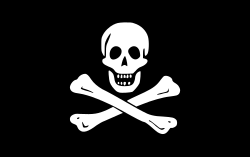海盜旗
此條目翻譯品質不佳。 (2022年3月31日) |
海盜旗(英語:Jolly Roger)是 18 世紀早期(海盜黃金時代後期),一些海盜船在發動襲擊前會升起的一類旗幟。

今天最常見的標誌是海盜旗—黑旗上的骷髏和交叉骨符號—在 1710 年代被許多海盜船長使用,包括塞繆爾·貝拉米、愛德華·英格蘭和約翰·泰勒(John Taylor)。 它繼續成為 1720 年代最常用的海盜旗,儘管其他設計也被使用。
實際運用狀況
编辑這種旗幟可能是為了傳達海盜的身份,這可能讓目標船隻有機會決定不戰而降。例如,1720 年 6 月,當巴塞洛繆·羅伯茨 (Bartholomew Roberts) 飄揚黑旗駛入紐芬蘭特雷帕西 (Trepassey) 港時,港內所有 22 艘船隻的船員都驚慌失措地棄船。[1]
使用該種旗幟是證明自己是海盜的可靠方式。僅僅擁有或使用該種旗幟就被認為是證明一個人是犯罪海盜而不是更合法的東西;只有海盜才敢使用該種旗幟,因為他已經面臨被處決的威脅。[2]
相關條目
编辑- 美國海軍第84戰鬥攻擊中隊 - 以海盜旗作為隊徽而著名,於1995年10月1日解編
- 美國海軍第103戰鬥攻擊中隊 - 上敘的VF-84中隊解編後,接續使用海盜旗作為隊徽
參考資料
编辑- ^ Burl, Aubery. Black Bart. : 133–34.
- ^ Leeson, Peter T. Pirational Choice: The Economics of Infamous Pirate Practices (PDF). 2008: 12 [2022-01-04]. (原始内容存档 (PDF)于2011-07-15). "Ships attacking under the death head's toothy grin were therefore considered criminal and could be prosecuted as pirates. Since pirates were criminals anyway, for them, flying the Jolly Roger was costless. If they were captured and found guilty, the penalty they faced was the same whether they used the Jolly Roger in taking merchant ships or not – the hangman's noose... For legitimate ships, however, things were different. To retain at least a veneer of legitimacy, privateers and Spanish coast guard ships could not sail under pirate colours. If they did, they could be hunted and hanged as pirates."